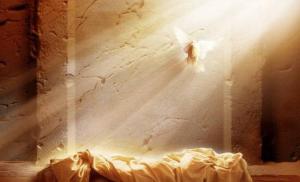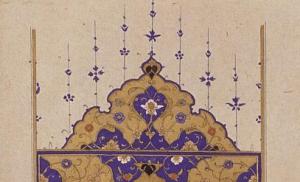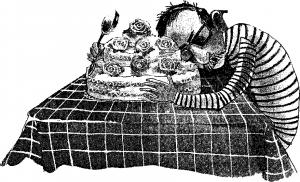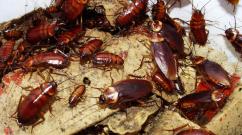How the school is indicated on the map. Topographical signs
"Mysterious" signs and designations on old maps. How roads, houses, churches, ravines, cemeteries, etc. were designated.





Explanation of some abbreviations and words on the MENDE map:
Buyan-field - Flat, elevated place, open on all sides
Vzlobok - A small steep hill.
Veres - Juniper.
Volok (Volok) - Forest or forest clearing
Vspolye - The edge of the field, pasture.
Vyselok (Vyselok) - A small village, predominantly owned, located near single-patrimonial villages.
Greatest - Greatest, highest, highest.
City (G.) - A fortified or walled village. Management status assigned to a volost, district or provincial in relation to other settlements.
Griva - An oblong hill covered with forest.
Village - A village without a church, whose inhabitants are mainly peasants from various departments and live without a landowner.
Right hand - Right hand.
Dresva - Coarse sand.
Zapan - Backwater or river bay.
Zaseka (Zas.) - Defensive structure. It was a combination of dead forest ambushes, an earthen rampart and a ditch with forts and separate fortresses. The fortifications served as defensive lines that protected against raids by the Golden Horde, who systematically plundered and destroyed Russian cities and villages and took the population into captivity, as well as to protect roads.
Zybun (Zyb.) - A quagmire, an impassable (disastrous) place.
Koshevnik - Wood timber floated down the river.
Cumulus sands (Kuch.) - Accumulations of loose sand around bushes and shrubs... Height 30-50 cm, less often up to 1-2 m. In places they consist of gravel. They usually form in areas with close groundwater - on salt marshes, the coasts of lakes, seas and rivers.
Lying meadow - Worthless, bad meadow.
Monastery, monastery (Mon.) - These consist of various types of monastic hostels, the latter of which sometimes coincide in their meaning with graveyards or estates of the spiritual department.
Grange (m. or Grange) - If it is owned, then most of it is near single-patrimonial villages, or it has the meaning of an estate at a plant and factory, if it belongs to persons of the tax-paying classes.
Myanda - Pine.
Novina - Cleared but not plowed land in the forest.
Dump (Opt.) - A mound of waste rock, slag, formed during the development of mineral resources.
Oselok - Oselok Vlad. wasteland, a place abandoned by its inhabitants; fallow, lie low. Oselok, Oblesye, Oselok or obselye, psk. hard newly populated place, settlement, new settlements, settlement.
Oselye - Oselye is akin to an outskirts, the land around the village.
Perekop - Ditch.
Tares - Weed
Pogost (Pog. or Pogost) - Has a church and a population consisting of clergy and clergy. The word graveyard comes from the word guest. The place where merchants traded was called a graveyard. With the adoption of Christianity, churches began to be built near graveyards. In the 15-16th centuries. churchyards begin to die off, hence the word graveyard has a second meaning - a lonely church.
Undercut (Under.) - A cleared place in the forest.
Disgrace - Review, watch.
Midnight - North.
Posad (P. or Pos.) - An order of huts or a row of houses. A settled settlement located outside a city or fortress.
Pochinok, village and farm (Poch.) - Same as settlement. Farmsteads, however, often have the significance of estates due to their agricultural nature. New settlements arising on the first raised site were called repairs. When the original courtyard was replaced by one or two others, it became a village.
Wasteland (Pust.) - A village turned into a wasteland if there were no residential courtyards left in it and the arable land was abandoned.
Selishche - A large village or settlement where there is more than one church.
Village (S.) - A village with a church, whose inhabitants are mainly peasants from different departments.
Seltso (Sel.) - A village of exclusively owner-occupied nature with a manor house and various owner-owned establishments, or a village in which a landowner with peasants or several landowners live. A village that was previously a village may also have the name.
Sloboda, Forshtat (Slob.) - A village with more than one church, a settlement outside a city or fortress.
Thorn - Prickly bush
Estate (Us.) - They are of two kinds. Estates of the spiritual department are similar in character to graveyards in terms of the nature of the population. Owner's estates differ either in their agricultural nature or as the location of landowners at a factory or plant
Shuitsa - Left hand.
Church land (CL) - A plot of land belonging to a church parish or monastery.
Information from the Lithuanian forum http://forum.violity.com Thank you, comrades!
Designations from old maps:
Interpretation of the signs used in the atlas of the Russian Empire of 1745:

Explanation of the signs used in the atlas of the Russian Empire 1820-27.

Explanations of the symbols used in the 1910 atlas.

Conventions used on the Western Special Map Russian Empire(Schubert map).
Symbols used in the Detailed militar map along the Russian border with Prussia, 1799.

P.S. Found treasures
Our trimaran, loaded with heavy diving equipment, half a ton of cargo, is heading south to the village of Khatgal, Mongolia, where the ancient ships found their final refuge.
Over the course of a week, we found and examined four vessels in Lake Khubsugul.
Declassified topographic maps of the USSR General Staff are freely floating around the Internet. We all love to download them, look at them, and often print them on sheets of paper for further use for their intended purpose - i.e. go hiking with them.
Topographic maps of the General Staff are the most accurate and best. Any other purchased maps printed in modern times will not carry as much accuracy and specificity. Conventional signs and symbols on topographic maps of the General Staff are much more complex than any other symbols on maps purchased in a store. We all remember them from geography lessons at school.
As an experienced user of such maps, I would like to describe at the beginning of this article the most important, in my opinion, designations. If the rest are more or less understandable, since they are almost all identical to other types of cards (not the General Staff), then these are something new and still incomprehensible. Actually, I will start with the symbols of rivers, fords, forests and roads.
Rivers and water resources
| Speed and direction of river flow (0.6 m/s) | |
|
Characteristics of rivers and canals: 30 - Width (m), 0,8 - Depth (m), TO- Soil type ( TO - rocky, P - sand, T - solid, IN - viscous) |
 |
| Water line mark, shore height above sea level (393m) |  |
| Brody: 0,3 - depth, 10 - length, TO- rocky soil, 1,0 - speed (m/sec) |  |
| The swamp is passable |  |
| The swamp is impassable |  |
| Bridge characteristics: D- construction material ( D - wooden, TO - stone, reinforced concrete - reinforced concrete), 43 - length of the bridge, 4 - width of the roadway (m), 10 - lifting capacity in tons |  |
| Forest clearing and width in meters (2m) |  |
| Field and forest roads |  |
| Winter road, a functioning road only in the winter season, during the cold period. Can go through swamps. |  |
| Dirt road, 6 - width of the roadway in meters |  |
| Gat - a road with a wooden surface, a flooring made of logs, 3 - width of the roadway |  |
| Go away |  |
| Railway track |  |
| Gas pipeline |  |
| Power lines (PTL) |  |
| Dismantled railway |  |
| Single track railway, narrow gauge. Also railway bridge |  |
| Highway: 6 —width of the covered part, 8 — the width of the entire road from ditch to ditch in meters; SCH- coating material ( B - cobblestone, G - gravel, TO - crushed stone, Shl - slag, SCH - crushed stone) |  |
Relief
| Steep river banks, rocky outcrops, Parma |  |
| Relief contours with relative height designation (260 m) |  |
| Mountainous area without vegetation, covered with kurum stones and rock outcrops |  |
| Mountainous area with vegetation and sparse trees, the forest border is visible |  |
| Outlier rocks with a height in meters |  |
| Glaciers |  |
| Rocks and rocky cliffs |  |
| Elevation mark (479.2 m) |  |
| Steppe region. Near the edge of the forest |  |
| Sands, deserts |  |
Photos of some geographical objects


The main winter road laid through the taiga forest. In summer there are thickets here (Yakutia)

Forest dirt road (Ivdel district, Northern Urals)

Gat - road with wooden covering (Lobnensky forest park, Moscow region)

Rock outcrop, Parma (Stone "Giant", Middle Urals)

Remnant rocks (Old Stone rock, Middle Urals)
It should be understood that all available topographic maps of the USSR General Staff have long been outdated. The information contained on them can date back to the 70-80s of the last century. If you are interested in the details of walking along certain trails, roads, the presence of settlements and geographical objects, then you should check in advance the reliability of the information from other sources. There may no longer be any paths or roads at all. Small settlements can be abandoned and look like wastelands, often already overgrown with young growth.
But, in any case, the maps of the General Staff still provide more accurate information, and using them you can more productively calculate your route and distance. In this article, I did not bother your heads with unnecessary symbols and symbols of topographic maps. I have posted only the most important and significant for the mountain-taiga and steppe region. Those interested in details can take a look.
Maps of the USSR General Staff were made using the Soviet system of layout and nomenclature of topographic maps. This system is still used in Russian Federation and in some former Soviet republics. There are newer maps, the state of the terrain on which is approximately 60-80s of the last century, and older maps, the so-called General Staff of the Red Army, made by geodetic reconnaissance of the pre-war period. “The maps are compiled in a conformal transverse cylindrical Gauss-Kruger projection, calculated using the parameters of the Krasovsky ellipsoid for a six-degree zone,” - and if you don’t understand, it doesn’t matter! The main thing is to remember (or write down, save this article) the points that I cited above. Knowing them, you can skillfully use maps and plan your route without using GPS.
Basic elements of map content. Scale, non-scale and explanatory symbols. Card design. General rules reading topographic maps
Basic elements of map content
Conventional signs are graphic symbols showing the position of an object on the ground and conveying its qualitative and quantitative characteristics. In the Russian Federation and the CIS countries, 465 symbols are used (in the USA - 243, in France - 288, in Germany - 231).
Groups of homogeneous local objects are depicted on maps using the main (basic) symbol. The qualitative and quantitative characteristics of objects of one group are determined by complicating the basic symbol.
The larger the scale of the map, the more objects and in greater detail are shown on it when depicting a given territory. As the scale of the map decreases, the information capacity of the images of various objects on it decreases.
On topographic maps of scale 1:25000 - 1:100000, whenever possible, all topographic objects and their characteristic features, important for the troops. On maps of scales 1:200000 and 1:500000 only the most significant of them are displayed, with a significant generalization of their planned outlines and other indicators.
Conventional signs of local objects are divided into three main groups:
Large-scale;
Non-scale;
Explanatory.
Scale (or outline) Conventional signs denote objects expressed on a map scale, that is, those whose dimensions (length, width, area) can be measured on the map.
Each such sign consists of a contour, i.e. a planned outline of the depicted object and an explanatory designation filling it in the form of background coloring, colored shading or a grid of icons (memory signs) identical in design, indicating the genus and variety of the object. The contours of objects are shown as dotted lines on maps if they do not coincide with other terrain lines (ditches, coastlines, roads, etc.), which are indicated by their own symbols.
Off-scale (point) Conventional signs depict small-sized objects (wells, individual houses, towers, monuments, etc.) that are not expressed on the scale of the map; the figured design of such a sign includes the main point showing the exact position of the object on the ground and indicates what kind of object it is.
Off-scale symbols can be divided into 4 groups depending on the position of the main point:
Signs that have a center of symmetry (circle, square, rectangle, asterisk, etc.); the main point coincides with the center of symmetry;
Signs that have a wide base, the main point is in the middle of the base;
Signs with a base in the form right angle; the main point is at the top of the corner;
Signs representing a combination of several figures; the main point is in the center the symmetry of the lower figure.
Geometric center of a figure
Rice. 1. 1 - points of the geodetic network; 2 - points of the survey network, fixed on the ground by centers; 3 - astronomical points; 4 - churches; 5 - plants, factories and mills without pipes; 6 - power plants; 7 - water mills and sawmills; 8 - fuel warehouses and gas tanks; 9 - active mines and adits; 10 - oil and gas wells without towers.
The middle of the base of the sign

Rice. 2 . 1 - factory and factory pipes; 2 - waste heaps; 3 - telegraph and radiotelegraph offices and departments, telephone exchanges; 4 - meteorological stations; 5 - semaphores and traffic lights; 6 - monuments, monuments, mass graves, tours and stone pillars more than 1 m high; 7 - Buddhist monasteries; 8 - separately lying stones.
The vertex of a right angle at the base of the sign

Rice. 3. 1 - wind engines; 2 - gas stations and gas stations4 3 - windmills; 4 - permanent river signaling signs; 5 - free-standing deciduous trees; 6 - free-standing coniferous trees
Geometric center of the bottom figure

Rice. 4. 1 - plants, factories and mills with pipes; 2 - transformer booths; 3 - radio stations and television centers; 4 - oil and gas rigs; 5 - tower-type structures; 6 - chapels; 7 - mosques; 8 - radio masts and television masts; 9 - kilns for burning lime and charcoal; 10 - mazars, suborgans.
These main points must be used when accurately measuring distances between objects on the map and when determining the coordinates of objects. Non-scale conventional signs include such signs of roads, streams and other linear objects, for which only the length is expressed on a scale, while the width cannot be measured on the map. The exact position of such objects on the ground corresponds to the longitudinal axis (middle) of the sign on the map.
Explanatory symbols are used for additional qualitative and quantitative characteristics of depicted objects and to show their varieties (for example, a symbol of a tree inside a forest).
Card design
Outline design of topographic maps. On each sheet of topographic map, on the outside of the frame, various information necessary for working with cardboard is placed.
Under the nomenclature the number and year of publication of the card are given.
Under the lower (south) side of the frame on the left, data on magnetic declination, convergence of meridians and direction correction is provided, and the drawing shows the relationship of these angular quantities; in the middle the linear and numerical scales of the map are placed, the scale value and the height of the relief section are indicated; to the right of the scale there is a depth scale, intended for determining the steepness of the slopes; on the right it indicates when and by what method the map was created. Data on the time of creation of the map allows us to judge the consistency of the map of the area at the moment (period).
Between the inner and outer lines of the frame of the map sheet, digitization of the vertical and horizontal lines of the coordinate (kilometer) grid and signatures of the geographic coordinates (latitude and longitude) of the corners of the frame are given.
The sides of the frame are divided into minute divisions (in latitude and longitude), and each minute division is divided into six parts of ten seconds each by dots.
In addition, at the exits of railways and highways the name of the nearest city, town or station where this road leads is given, indicating the distance in kilometers from the frame to this populated area (station).
Inside the frames, the proper names of settlements are also written, which are only partially depicted on this sheet, and most of them are located on the adjacent sheet.
General rules for reading topographic maps
Reading a map means correctly and fully perceiving the symbolism of its conventional signs, quickly and accurately recognizing from them not only the type and varieties of objects depicted, but also their characteristic properties.
Studying an area using a map (reading a map) includes determining its general nature, quantitative and qualitative characteristics individual elements(local objects and forms of relief), as well as determining the degree of influence of a given area on the organization and conduct of combat.
When studying an area using a map, you should remember that since its creation, changes may have occurred in the area that are not reflected on the map, i.e., the contents of the map will to some extent not correspond to the actual state of the area at the moment. Therefore, it is recommended to begin studying the area using a map by familiarizing yourself with the map itself.
Familiarization with the map. When familiarizing yourself with the map, based on the information placed in the outer frame, the scale, height of the relief section and the time of creation of the map are determined. Data on the scale and height of the relief section will allow you to establish the degree of detail of the image on a given map of local objects, shapes and relief details. Knowing the scale, you can quickly determine the size of local objects or their distance from each other.
Information about the time of creation of the map will make it possible to preliminarily determine the correspondence of the contents of the map to the actual state of the area.
Then they read and, if possible, remember the values of the magnetic needle declination and direction corrections. Knowing the direction correction from memory, you can quickly convert directional angles to magnetic azimuths or orient the map on the ground along the kilometer grid line.
General rules and sequence of studying the area on the map. The sequence and degree of detail in studying the terrain is determined by the specific conditions of the combat situation, the nature of the unit's combat mission, as well as seasonal conditions and tactical and technical data of the military equipment used in carrying out the assigned combat mission. When organizing defense in a city, it is important to determine the nature of its planning and development, identifying durable buildings with basements and underground structures. In the case where the unit’s route passes through the city, there is no need to study the features of the city in such detail. When organizing an offensive in the mountains, the main objects of study are passes, mountain passages, gorges and gorges with adjacent heights, the shape of the slopes and their influence on the organization of the fire system.
The study of terrain, as a rule, begins with determining its general nature, and then studies in detail individual local objects, shapes and details of the relief, their influence on the conditions of observation, camouflage, cross-country ability, protective properties, conditions of fire and orientation.
Determining the general nature of the area is aimed at identifying the most important features of the relief and local objects that have a significant impact on the accomplishment of the task. When determining the general nature of an area based on familiarization with the terrain, settlements, roads, hydrographic network and vegetation cover, the variety of the area, the degree of its ruggedness and closedness are identified, which makes it possible to preliminarily determine its tactical and protective properties.
The general character of the area is determined by a quick overview of the entire study area on a map.
At first glance at the map, one can tell that there are settlements and individual tracts of forest, cliffs and gullies, lakes, rivers and streams indicating rough terrain and limited visibility, which inevitably complicates the movement of military and transport equipment off roads and creates difficulties in organizing surveillance . At the same time, the rugged nature of the terrain creates good conditions for sheltering and protecting units from the effects of enemy weapons of mass destruction, and forests can be used to camouflage unit personnel, military equipment, etc.
Thus, as a result of determining the general nature of the terrain, a conclusion is made about the accessibility of the area and its individual directions for operations by units on vehicles, and also outline lines and objects that should be studied in more detail, taking into account the nature of the combat mission to be performed in this area of the terrain.
A detailed study of the area aims to determine the qualitative characteristics of local objects, forms and details of the relief within the boundaries of the unit’s operations or along the upcoming route of movement. Based on obtaining such data from a map and taking into account the relationship of topographic elements of the terrain (local objects and relief), an assessment is made of the conditions of cross-country ability, camouflage and surveillance, orientation, firing, and the protective properties of the terrain are determined.
Determination of the qualitative and quantitative characteristics of local objects is carried out using a map with relatively high accuracy and great detail.
When studying settlements using a map, the number of settlements, their type and dispersion are determined, and the degree of habitability of a particular area (district) of the area is determined. The main indicators of the tactical and protective properties of settlements are their area and configuration, the nature of the layout and development, the presence of underground structures, and the nature of the terrain on the approaches to the settlement.
By reading the map, using the conventional signs of settlements, they establish the presence, type and location of them in a given area of the area, determine the nature of the outskirts and layout, the density of
construction sites and fire resistance of buildings, location of streets, main passages, presence of industrial facilities, prominent buildings and landmarks.
When studying a road network map, the degree of development of the road network and the quality of roads are clarified, the traffic conditions of a given area and the possibility of efficient use of vehicles are determined.
A more detailed study of roads establishes: the presence and characteristics of bridges, embankments, excavations and other structures; the presence of difficult areas, steep descents and ascents; possibility of leaving roads and driving near them.
When studying unpaved roads, special attention is paid to identifying the carrying capacity of bridges and ferry crossings, since on such roads they are often not designed to accommodate heavy wheeled and tracked vehicles.
By studying hydrography, the presence of water bodies is determined from the map, and the degree of ruggedness of the area is specified. The presence of water bodies creates good conditions for water supply and transportation on waterways.
Water surfaces are depicted on maps in blue or light blue, so they clearly stand out among the symbols of other local objects. When studying rivers, canals, streams, lakes and other water barriers using a map, the width, depth, flow speed, nature of the bottom soil, banks and surrounding areas are determined; the presence and characteristics of bridges, dams, locks, ferry crossings, fords and areas convenient for crossing are established.
When studying the soil and vegetation cover, the presence and characteristics of forests and shrubs, swamps, salt marshes, sands, rocky placers and those elements of the soil and vegetation cover that can have a significant impact on the conditions of passage, camouflage, observation and the possibility of shelter are determined from the map.
The characteristics of the forest area studied from the map allow us to draw a conclusion about the possibility of using it for a secretive and dispersed location of units, as well as about the passability of the forest along roads and clearings. Good landmarks in the forest for determining your location and orienting yourself while moving are the forester’s house and clearings.
The characteristics of swamps are determined by the outline of symbols. However, when determining the passability of swamps on a map, one should take into account the time of year and weather conditions. During the period of rains and muddy roads, swamps, shown on the map as passable by a symbol, may actually turn out to be difficult to pass. In winter during severe frosts difficult swamps can become easily passable.
Studying the terrain on a map begins with determining the general nature of the unevenness of the area of the terrain on which the combat mission is to be carried out. At the same time, the presence, location and mutual relationship of the most typical typical forms and relief details for a given area are established, their influence on the conditions of cross-country ability, observation, firing, camouflage, orientation and organization of protection against weapons of mass destruction is determined in general terms. The general nature of the relief can be quickly determined by the density and outline of contours, elevation marks and symbols of relief details.
A detailed study of the terrain on a map is associated with solving problems of determining the heights and mutual elevation of points, the type and direction of the steepness of the slopes, the characteristics (depth, width and length) of hollows, ravines, gullies and other relief details.
Naturally, the need to solve specific problems will depend on the nature of the assigned combat mission. For example, the determination of invisibility fields will be required when organizing and conducting surveillance reconnaissance; determining the steepness, height and length of the slopes will be required when determining terrain conditions and choosing a route, etc.
Scale, or contour, conventional topographical signs are used to depict local objects whose size can be expressed on a map scale, that is, their dimensions (length, width, area) can be measured on the map. For example: lake, meadow, large gardens, residential areas. The contours (external boundaries) of such local objects are depicted on the map with solid lines or dotted lines, forming figures similar to these local objects, but only in a reduced form, that is, on the scale of the map. Solid lines show the contours of neighborhoods, lakes, and wide rivers, and the contours of forests, meadows, and swamps are dotted.
Figure 31.
Constructions and buildings expressed on the scale of the map are depicted with figures similar to their actual outlines on the ground and are painted over in black. Figure 31 shows several on-scale (a) and out-of-scale (b) symbols.
Off-scale symbols
Explanatory topographic signs serve for additional characterization of local objects and are used in combination with large-scale and non-scale signs. For example, a figurine of a coniferous or deciduous tree inside the outline of a forest shows the dominant tree species in it, an arrow on a river indicates the direction of its flow, etc.
In addition to signs, maps use full and abbreviated signatures, as well as digital characteristics of some objects. For example, the signature “mash.” with a plant sign means that this plant is a machine-building plant. The names of settlements, rivers, mountains, etc. are fully signed.
Digital symbols are used to indicate the number of houses in rural settlements, the height of the area above sea level, the width of the road, the characteristics of the load capacity and the size of the bridge, as well as the size of trees in the forest, etc. Digital symbols related to conventional relief signs are printed brown, the width and depth of rivers are in blue, everything else is in black.
Let us briefly consider the main types of topographic symbols for depicting the area on the map.
Let's start with the relief. Due to the fact that the conditions of observation largely depend on its nature, the terrain's passability and its protective properties, the terrain and its elements are depicted on all topographic maps in great detail. Otherwise, we could not use the map to study and evaluate the area.
In order to clearly and completely imagine the area on the map, you must first of all be able to quickly and correctly determine on the map:
Types of unevenness of the earth's surface and their relative location;
Mutual elevation and absolute heights of any terrain points;
The shape, steepness and length of the slopes.
On modern topographic maps, the relief is depicted by horizontal lines, that is, curved closed lines, the points of which are located on the ground at the same height above sea level. To better understand the essence of depicting relief with horizontal lines, let’s imagine an island in the form of a mountain, gradually flooded with water. Let us assume that the water level sequentially stops at equal intervals, equal in height to h meters (Fig. 32).
Then each water level will have its own coastline in the form of a closed curved line, all points of which have the same height. These lines can also be considered as traces of the cross-section of uneven terrain by planes parallel to the level surface of the sea, from which heights are calculated. Based on this, the height distance h between the secant surfaces is called the section height.
Figure 32.
So, if all lines of equal heights are projected onto the level surface of the sea and depicted to scale, then we will receive an image of the mountain on the map in the form of a system of curved closed lines. These will be the horizontal lines.
In order to find out whether it is a mountain or a basin, there are slope indicators - small lines that are drawn perpendicular to the horizontal lines in the direction of the descent of the slope.
Figure 33.
The main (typical) landforms are presented in Figure 32.
The height of the section depends on the scale of the map and the nature of the relief. The normal height of the section is considered to be a height equal to 0.02 of the map scale, that is, 5 m for a map of scale 1:25,000 and, accordingly, 10, 20 m for maps of scales 1: 50,000, 1: 100,000. Contour lines on the map corresponding to those established for below the height of the section, are drawn in solid lines and are called main or solid horizontal lines. But it happens that at a given section height, important details of the relief are not expressed on the map, since they are located between the cutting planes.
Then half semi-horizontal lines are used, which are drawn through half the main height of the section and are plotted on the map with broken lines. To determine the count of contours when determining the height of points on the map, all solid contours corresponding to five times the height of the section are drawn thickly (thickened contours). So, for a map of scale 1: 25,000, each horizontal line corresponding to the section height of 25, 50, 75, 100 m, etc. will be drawn as a thick line on the map. The main section height is always indicated below the south side of the map frame.
The heights of the elevations in the area shown on our maps are calculated from the level of the Baltic Sea. The heights of points on the earth's surface above sea level are called absolute, and the elevation of one point over another is called relative elevation. Contour marks - digital inscriptions on them - indicate the height of these terrain points above sea level. The top of these numbers always faces the upward slope.
Figure 34.
Marks of command heights, from which the terrain from the most important objects on the map (large settlements, road junctions, passes, mountain passes, etc.) is better visible than from others, are marked in large numbers.
Using contour lines you can determine the steepness of slopes. If you look closely at Figure 33, you can see from it that the distance between two adjacent contour lines on the map, called the lay (at a constant section height), changes depending on the steepness of the slope. The steeper the slope, the smaller the overlay and, conversely, the lower the slope, the greater the overlay. The conclusion follows from this: steep slopes on the map will differ in the density (frequency) of contours, and in flat places the contours will be less frequent.
Usually, to determine the steepness of the slopes, a drawing is placed in the margins of the map - depth scale(Fig. 35). Along the lower base of this scale are numbers that indicate the steepness of the slopes in degrees. The corresponding values of the deposits on the map scale are plotted on perpendiculars to the base. On the left side, the depth scale is built for the main section height, on the right - at five times the section height. To determine the steepness of the slope, for example, between points a-b(Fig. 35), you need to take this distance with a compass and put it on the position scale and read the steepness of the slope - 3.5°. If you need to determine the steepness of the slope between the horizontal thickened p-t, then this distance must be plotted on the right scale and the slope of the slope in this case will be equal to 10°.
Figure 35.
Knowing the properties of contour lines, you can determine the shape from the map various types stingrays (Fig. 34). For an even slope, the depths will be approximately the same throughout its entire length; for a concave slope, they increase from the top to the bottom; and for a convex slope, on the contrary, the formations decrease towards the bottom. In wavy slopes, the positions change according to the alternation of the first three forms.
When depicting relief on maps, not all of its elements can be expressed as contours. So, for example, slopes with a steepness of more than 40° cannot be expressed as horizontals, since the distance between them will be so small that they will all merge. Therefore, slopes that have a steepness of more than 40° and are steep are indicated by horizontal lines with dashes (Fig. 36). Moreover, natural cliffs, ravines, gullies are indicated in brown, and artificial embankments, recesses, mounds and pits are indicated in black.
Figure 36.
Let's consider the basic conventional topographical signs for local objects. Settlements are depicted on the map while maintaining external boundaries and layout (Fig. 37). All streets, squares, gardens, rivers and canals, industrial enterprises, outstanding buildings and structures of landmark significance are shown. For better clarity, fire-resistant buildings (stone, concrete, brick) are painted over orange, and blocks with non-fire-resistant buildings - yellow. The names of settlements on maps are written strictly from west to east. The type of administrative significance of a settlement is determined by the type and size of the font (Fig. 37). Under the signature of the name of the village you can find a number indicating the number of houses in it, and if there is a district or village council in the settlement, the letters “RS” and “SS” are additionally placed.
Figure 37 - 1.
Figure 37 - 2.
No matter how poor the area is in local objects or, on the contrary, saturated, there are always individual objects on it that, by their size, stand out from the rest and are easily identified on the ground. Many of them can be used as guides. This should include: factory chimneys and prominent buildings, tower-type buildings, wind turbines, monuments, gas pumps, signs, kilometer posts, free-standing trees, etc. (Fig. 37). Most of them, due to their size, cannot be shown on the scale of the map, so they are depicted on it as out-of-scale signs.
The road network and crossings (Fig. 38, 1) are also depicted with out-of-scale symbols. Data on the width of the carriageway, road surface, indicated on the conventional signs, make it possible to evaluate their throughput, load capacity, etc. Depending on the number of tracks, railways are indicated by dashes across the conventional road sign: three dashes - three-track, two dashes - double-track railway . Stations, embankments, excavations, bridges and other structures are shown on railways. For bridges longer than 10 m, its characteristics are signed.
Figure 38 - 1.
Figure 38 - 2.
Figure 39.
For example, the signature on the bridge ~ means that the length of the bridge is 25 m, the width is 6 m, and the load capacity is 5 tons.
Hydrography and structures associated with it (Fig. 38, 2), depending on the scale, are shown in greater or less detail. The width and depth of the river is written as a fraction 120/4.8, which means:
The river is 120 m wide and 4.8 m deep. The speed of the river flow is shown in the middle of the symbol with an arrow and a number (the number indicates the speed of 0.1 meters per second, and the arrow indicates the direction of the flow). On rivers and lakes, the height of the water level during low water (water line mark) in relation to sea level is also indicated. For fords it is signed: in the numerator - the depth of the ford in meters, and in the denominator - the quality of the soil (T - hard, P - sandy, V - viscous, K - rocky). For example, br. 1.2/k means that the ford is 1.2 m deep and the bottom is rocky.
Soil and vegetation cover (Fig. 39) is usually depicted on maps with large-scale symbols. These include forests, shrubs, gardens, parks, meadows, swamps, salt marshes, as well as sand, rocky surfaces, and pebbles. Its characteristics are indicated in the forests. For example, for a mixed forest (spruce with birch) the numbers are 20/\0.25 - this means that the average height of the trees in the forest is 20 m, their average thickness is 0.25 m, and the average distance between tree trunks is 5 meters.
Figure 40.
Swamps are depicted depending on their passability on the map: passable, difficult to pass, impassable (Fig. 40). Passable swamps have a depth (to solid ground) of no more than 0.3-0.4 m, which is not shown on maps. The depth of impassable and impassable swamps is written next to the vertical arrow indicating the location of the measurement. On the maps, the corresponding symbols show the cover of the swamps (grass, moss, reed), as well as the presence of forests and shrubs on them.
Lumpy sands differ from smooth sands and are indicated on the map with a special symbol. In the southern steppe and semi-steppe regions there are areas with soil richly saturated with salt, which are called salt marshes. They are wet and dry, some are impassable and others are passable. On maps they are indicated by conventional symbols - “shading” blue. An image of salt marshes, sands, swamps, soil and vegetation cover is shown in Figure 40.
Off-scale symbols of local objects
Answer: Off-scale symbols are used to depict small local objects that cannot be expressed on a map scale - free-standing trees, houses, wells, monuments, etc. When depicting them on a map scale, they would appear in the form of a point. Examples of depicting local objects with out-of-scale symbols are shown in Figure 31. The exact location of these objects, depicted with out-of-scale symbols (b), is determined by the center of the symmetrical figure (7, 8, 9, 14, 15), in the middle of the base of the figure (10, 11) , at the top of the corner of the figure (12, 13). Such a point on the figure of an off-scale symbol is called the main point. In this figure, the arrow shows the main points of symbols on the map.
It is useful to remember this information in order to correctly measure the distance between local objects on the map.
(This question is discussed in detail in question No. 23)
Explanatory and conventional signs of local objects
Answer: Types of topographical symbols
The terrain on maps and plans is depicted by topographical symbols. All conventional signs of local objects, according to their properties and purpose, can be divided into the following three groups: contour, scale, explanatory.
To depict various objects and processes, their qualitative and quantitative characteristics on maps, a special language is used - symbols (symbols).
Symbols on geographical maps perform two functions at once - they determine the spatial position of objects and indicate their appearance and some characteristics. There are area (or scale), linear, non-scale and explanatory symbols. The list of all symbols used on the map and their explanations contains legend to the map. From reading the legend you can get an idea of the map without looking at it.
Objects depicted on maps can be any objects, phenomena or processes. A wide variety of methods are used to depict them. Let's look at the cards we already know.
The relief of the Earth is depicted layer-by-layer painting. Thus, lowlands with heights from 0 to 200 m are painted over green, and hills with heights from 200 to 500 m are light brown. What height each color corresponds to can be seen from the table at the bottom of the map. It's called the height scale. Using it, you can quickly determine the approximate height of any part of the territory. The depth scale is also constructed. The heights of some mountain peaks or lowlands, as well as the depths of ocean trenches, are shown on the map and globe in meters.
Earth's mineral resources (coal, oil, gas, gold, diamonds, etc.) are shown on the map special icons. These are international icons, they are understandable to everyone.
Isolines(from the Greek isos - equal) - lines on geographical maps, passing through points with the same values of some geographical phenomenon, For example, atmospheric pressure — isobars, air temperature - isotherms, height of the earth's surface - isohypses (horizontal).
Method of habitats used on maps of vegetation, fauna, and forest maps. With its help, the distribution areas (areas) of certain species of plants, animals or forests of different composition are shown: coniferous, mixed, etc.
Traffic signs depict movement of various objects and phenomena on the map: sea currents, winds, air masses, as well as transport of goods and passengers.
High quality background used, for example, to depict the religious or national composition of the population.
Card chart depicts on the map geographical features or phenomena with diagrammatic figures, for example, the industry of large cities on an industrial map.
Map- a schematic map that does not have a grid, depicts geographical objects and phenomena simply and clearly. For example, a map of the weather, a map of the country’s trade relations, maps of routes and travel, etc.
Selected symbols for topographic plans at scales 1:500 and 1:1000:
| № | Name with characteristics of the topographic object | Conventional topographic signs on the terrain plan |
|---|---|---|
| 1 | Points of the state geodetic network | |
| 2 |  |
|
| 3 |  |
|
| 4 |  |
|
| 5 |  |
|
| 6 |  |
|
| 7 |  |
|
| 8 |  |
|
| 9 | ||
| 10 | Buildings: Residential fire-resistant: (stone, brick, concrete) 1) one-story; 2) more than one floor | 1) 2) |
| 11 | Fire-resistant non-residential buildings: (stone, brick, concrete) 1) one-story; 2) more than one floor | 1) 2) |
| 12 | Non-fire-resistant residential buildings: (wooden, adobe, etc.) 1) one-story; 2) more than one floor | 1) 2) |
| 13 | Non-residential buildings are non-fire-resistant (wooden, adobe, etc.) 1) one-story; 2) more than one floor | 1) 2) |
| 14 | Buildings under construction |  |
| 15 | Dilapidated and destroyed buildings |  |
| 16 | Floor height mark for the first floor (inside the contour); Ground mark on the corner of the house |  |
| 17 | Church buildings: 1) stone with domes of different heights; 2) wooden with one dome | 1)  2) 2)  |
| 18 | Mosques: 1) stone; 2) wooden | 1)  2) 2)  |
| 19 | Small buildings: 1) individual garages; 2) toilets | 1)  2) 2)
|
| 20 | Slopes: Unreinforced (number 2, 5 – slope height in meters) |  |
| 21 | Unreinforced slopes (figure 102, 5 – slope height in meters) |  |
| 22 | Reinforced slopes (number 102, 5 – slope height in meters; inscription - a method of strengthening) |  |
| 23 | Open-pit mining of solid minerals (quarries, etc.) (figure – depth in meters) |  |
| 24 | Gas stations | |
| 25 | Electrical substations, transformer booths with their numbers |  |
| 26 | Wells and wells combined with water towers | |
| 27 | Electric lights on poles |  |
| 28 | Inspection wells (hatches) of underground communications: 1) without appointment; 2) on water supply networks; 3) on sewer networks; 4) on heating networks; 5) on gas pipelines |
1) 2) 3) 4) |
| 29 | Power transmission lines (power lines) in an undeveloped area (numbers - truss heights in meters, voltage in kV, number of wires or cables): 1) high voltage power lines on reinforced concrete trusses; 2) high voltage power lines on metal trusses; 3) high-voltage cable overhead power lines on reinforced concrete and wooden poles; 4) Low voltage power lines on metal and wooden poles |
1)  2) 2)  3)  4) 4)  |
| 30 | Power lines (power lines) in a built-up area: 1) high voltage power lines on wooden trusses; 2) high voltage power lines on poles; 3) high-voltage cable overhead power lines on poles; 4) Low voltage power lines on wooden poles |
1)  2) 2) 3) 4) |
| 31 | Pipelines: Above ground ( G– gas pipeline, IN– water supply, TO– sewerage, N– oil pipelines; pipe material - bet., st. etc.; numbers – pipe diameter in millimeters): 1) above-ground on the ground; 2) on supports (numbers – height of supports in meters) | 1) 2)  |
| 32 | Underground pipelines: 1) pipelines with inspection wells (numbers – numbers and elevations of wells; Ch. 1, 2— depth of pipes); 2) pipelines laid side by side in one trench (numbers - number of gaskets); 3) direction of fluid flow in gravity gaskets | 1)  2)  3)  |
| 33 | Waste grates | |
| 34 | Above-water pipelines on supports (green wash) |  |
| 35 | Pipelines on the bottom surface (green wash) |  |
| 36 | Communication lines and technical means overhead wire controls (telephone, radio, television, etc.) |  |
| 37 | Masts, towers, radio and television repeaters (the numbers are their heights in meters) |  1:1000 1:500 1:1000 1:500
|
| 38 | Landfill (dashed lines in brown) |  |
| 40 | Wasteland, Construction sites | |
| 42 | Roads: 1) highways (covering material – concrete); cuvettes in green. 2) roads with improved surface (asphalt); cuvettes in green. |
1)  2) |
| 43 | Roadways and sidewalks: Pink wash 1) roadways of streets with curb stones; 2) roadways of streets without side stones; 3) paved sidewalks; 4) unpaved sidewalks |
 |
| 44 | Unpaved roads: 1) improved dirt roads; cuvettes in green. 2) dirt roads (field, forest, country roads); |
1)  2)  3) |
| 45 | Roads in excavations (numbers – depth of excavations in meters); cuvettes in green. |  |
| 46 | Railways |  |
| 47 | Narrow gauge railways (purpose and gauge in millimeters) |  |
| 48 | Railways on embankments (figures – height of embankments in meters) |  |
| 49 | Station tracks |  1:1000 1:1000  1:500 1:500
|
| 50 | Pedestrian bridges over railways (letters - bridge material) |  |
| 52 | Horizontals (in brown): 1) thickened (through a given interval of section height); 2) basic; 3) semi-horizontal (half the height of the section); 4) quarter-horizontal (at 1/4 of the section height) |
1)  2)  3)  4)  |
| 53 | Slope direction indicators (berg strokes) |  |
| 54 | Elevation marks | |
| 55 | Earthen cliffs (in brown): (numbers – depth in meters) |  |
| 56 | Pits (numbers – depth in meters) |  |
| 57 | Mounds (numbers – height in meters) |  |
| 59 | Watercourses, coastlines and water edge markers (elevation and date of measurement), Land and water boundaries in green, shaded in blue. |  |
| 60 | Streams (width not expressed in plan scale) in blue. |  |
| 61 | Characteristics of watercourses: 1) direction and speed of flow in m/s; 2) width in meters (numerator), depth in meters and bottom soil (denominator) |  |
| 62 | Bridges: 1) on a general span structure (metal - metal, stone - stone, reinforced concrete - reinforced concrete, numbers - load capacity in tons); 2) small wooden ones; 3) on foot |
1)  2) 2) 3) |
| 63 | Vegetation: Contours of vegetation, agricultural land, soil, etc. |  |
| 64 | Characteristics of forest tree stands by composition: 1) deciduous; 2) conifers; 3) mixed; according to qualitative data: 4) average height of trees in meters (numerator), average thickness of trunks in meters (denominator), average distance between trees in meters (number on the right), tree species | 1) 2) 3) 4)  |
| 65 | Natural high forests |  |
| 66 | Young forest plantations (figure – average height in meters) |  |
| 67 | Forest areas cut down |  |
| 68 | Shrubs separate groups |  |
| 69 | Thickets (indicating species and average height) |  |
| 70 | Vegetation is herbaceous, meadow |  |
| 71 | Fruit orchards (figure – average height in meters) |  |
| 72 | Lawns, flower beds |  |
| 73 | Arable land |  |
| 74 | Hayfields with groups of bushes |  |
| 75 | Pasture with open woodland |  |
| 76 | Soils: 1) smooth sands (brown); |














